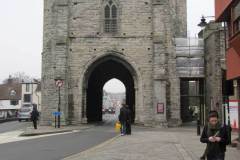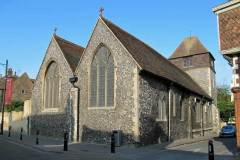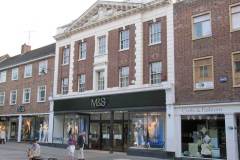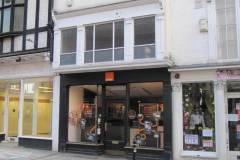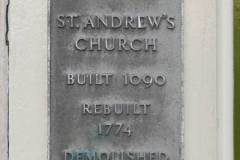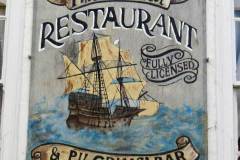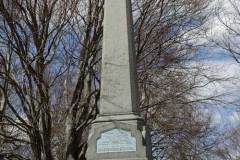(1578-1625) Early pilgrim, organiser of the Mayflower voyage to America
Robert Cushman was born in Rolvenden near Tenterden in Kent in 1578. His ancestry remains a matter of dispute, despite detailed research by those studying the early American pilgrims, but we know he was baptised in Rolvenden parish church on 9 February that year. He moved in early life to Canterbury where in the late 1590s he took an apprenticeship with the grocer and tallow candle maker George Masters. Robert was also active in the Puritan movement, which was challenging the beliefs and practices of the established church, and this led to his examination before the Canterbury Diocesan Court in 1603.
However, he continued his Puritan activities, and in 1605 appeared before the local Quarter Sessions for non-attendance at services. He was later excommunicated and served a short prison sentence in the small goal above the Westgate (image 1). In 1606, aged 28, he married Sarah Reder, a local girl then living in the Cathedral precincts – the service took place in St Alphege church (image 2). George Master’s grocery and store traded in the Whitefriars area of the city on the site of what is now M&S (image 3). A nearby property had been the home of Christopher Marlowe. Robert went on to run his own store on the site of what is now 13 The Parade (image 4), currently the Orange mobile shop, and become a freeman of the city. Their child Thomas was born here in 1607, and baptised in nearby St Andrew’s church (image 5). Fearing further religious persecution, the family moved in 1611 to Leiden in the Low Countries (now Holland), where they lived with other Puritan exiles. Robert’s leadership skills and managerial flair were recognised in his work for the Leiden community, and in 1617, following the early death of his wife Sarah, he returned to England to negotiate the financing and hiring of the Mayflower to take pilgrims to America. He spent some of this time at an inn in Palace Street, now the Mayflower Restaurant (image 6 – painting was recently removed), and may well have been staying here when the Mayflower contract was agreed. Robert’s plan was to sail to America with his son on a sister ship the Speedwell. This failed when, early in the voyage, the Speedwell proved unseaworthy, but Robert and son Thomas made it to Plymouth in America in 1621 on the Fortune. Later that year, Robert returned to England to further the interests of the early colonists. Recent research has shown that Robert died in 1625 whilst visiting relatives in Benenden (Kent) – see below for source details.
Cushman has little by way of memorials in Canterbury, although the painting of the Mayflower at 59 Palace Street reminds us of our link with the early pilgrims and there is a road named after him in Wincheap. A Cushman memorial does stand in Burial Hill outside Plymouth Massachusetts, a 25 ft granite column that dominates the hill. Thomas Cushman became Ruling Elder of the Plymouth community, and married Mary Allerton, the last surviving Mayflower passenger, who was also from a Canterbury family. Their direct descendants, from their 50 grandchildren, include President Franklin D Roosevelt and President Zachary Taylor.
Sources: Bateman (1984); Bateman (2001); Boyle (1974); Lyle (2002); Woodman (1995)
A helpful web site (but it’s disturbing that the author thinks Canterbury is part of Plymouth!): http://minerdescent.wordpress.com/2010/08/06/robert-cushman/
The recent research on the burial place of Robert Cushman can be seen in The Register, Journal of American Genealogy, New England Historic Genealogical Society (Winter 2018) ‘The 1625 Death of Pilgrim Robert Cushman in Benenden, Kent’ by Michael R Paulick and Robert C Cushman. The same authors have produced ‘Robert Cushman, Mayflower Pilgrim in Canterbury 1596-1607′ (Mayflower Quarterly Vol 79 No 3) and The Probable Origins of Sara Reader, First Wife of Robert Cushman’ (Mayflower Journal vol I No II Fall 2016) – both refer to Canterbury and to Canterbury records.
Church court records for 1603 (CCA-DCb-PRC/44/3) and Quarter Session papers for 1606 (CCA-CC-J/Q/405/vi) can be seen at Canterbury Cathedral Archives
For family links between Cushmans and President Roosevelt see https://famouskin.com/famous-kin-chart.php?name=14930+robert+cushman&kin=8952+franklin+d+roosevelt
For family links between Cushmans and President Taylor see https://famouskin.com/famous-kin-chart.php?name=35269+isaac+cushman&kin=7872+zachary+taylor&via=7867+isaac+allerton
DL
Update (2013) the Mayflower painting (Image 6) has now been removed from the exterior wall and hangs inside the building

